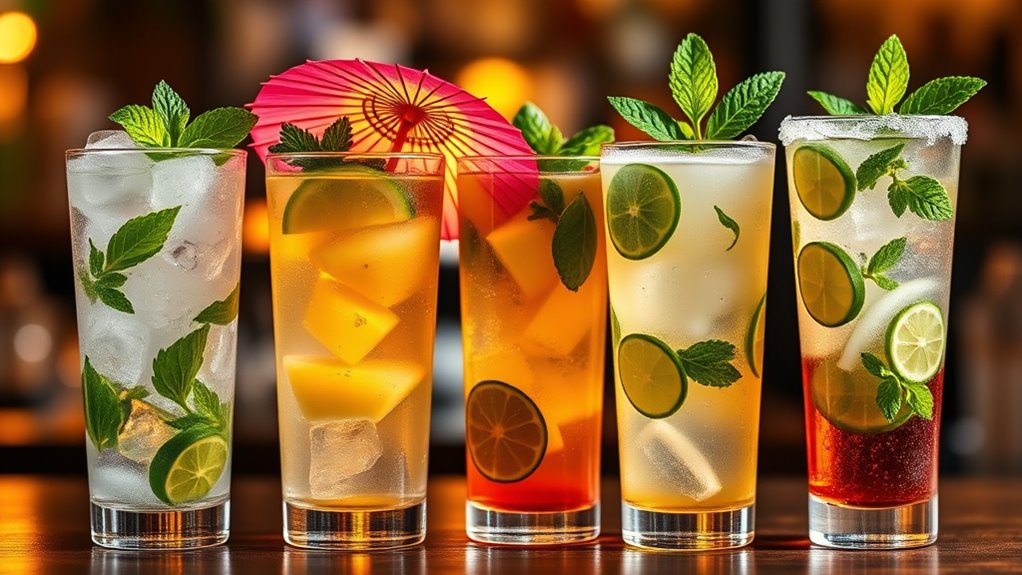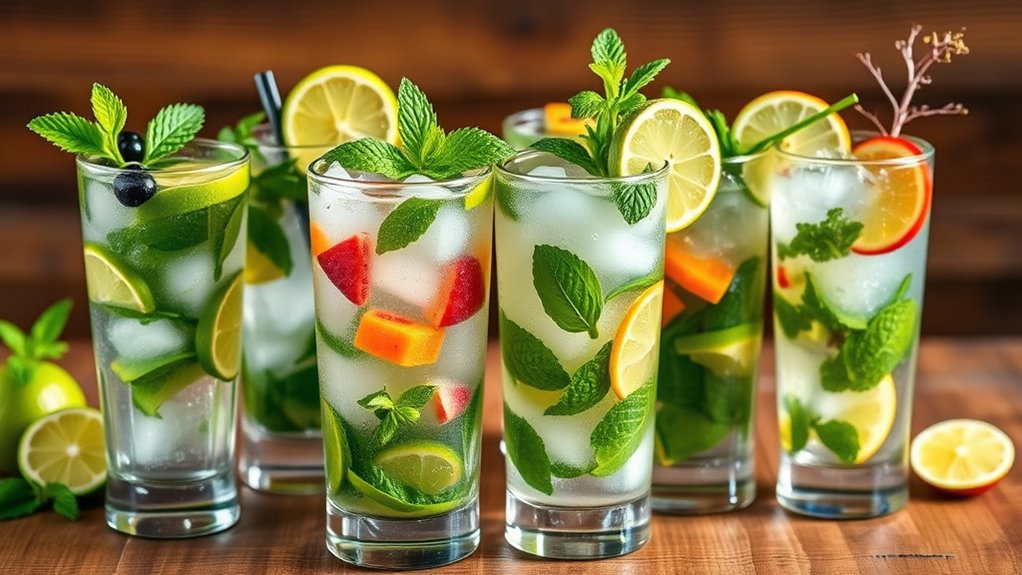Mojitos around the world showcase exciting variations that reflect different rum choices, regional ingredients, and fruit infusions. You might enjoy a Caribbean-style mojito with coconut rum or a tropical twist with pineapple and mango. Some versions add berries or passionfruit for extra flavor and color, while others incorporate ginger or lemongrass for aromatic flair. Exploring these differences can inspire your own creations—there’s much more to discover in each revitalizing sip.
Key Takeaways
- Different regions adapt mojitos with local ingredients like coconut rum in the Caribbean or ginger in Asia.
- Variations include adding fruits such as berries, pineapple, or mango for unique flavors and visual appeal.
- Rums range from light white to rich aged or spiced, influencing the cocktail’s complexity and regional style.
- European versions often use dry, aged rums paired with berries or citrus for a refined taste.
- The mojito’s versatility allows for personalized adjustments, reflecting local tastes and ingredient availability worldwide.

A mojito is more than just an invigorating Cuban cocktail—it’s a global sensation that has traveled far beyond its Caribbean roots. When you order a mojito anywhere in the world, you’ll find that bartenders put their own twist on the classic recipe, often experimenting with different rum varieties and fruit infusions to create unique flavor profiles. The foundation of any mojito is, of course, the rum, and the choices you have can considerably influence the drink’s character. Traditional white rum offers a light, crisp taste that lets the mint and lime shine, but some places might use gold or spiced rum to add depth and complexity. These varieties can bring subtle caramel or cinnamon notes, transforming the familiar drink into something richer and more layered.
The rum choice in a mojito influences its depth, from light white to rich spiced varieties.
Fruit infusions are another way to elevate your mojito experience. While the classic calls for muddled lime and mint, many bartenders now incorporate additional fruits like berries, pineapple, or mango. These infusions lend a sweet, tangy dimension that complements the invigorating mint and lime base. For example, a strawberry or raspberry mojito introduces a vibrant color and a burst of fruity flavor with each sip. Pineapple or mango can add tropical sweetness, making the cocktail even more evocative of summer or exotic locales. You might also encounter versions with muddled passionfruit or kiwi, which bring a tartness and visual appeal that make the drink more visually striking and flavorful.
As you explore mojitos around the world, you’ll notice that the core elements—mint, lime, rum—remain consistent, but the variations reflect local tastes and ingredients. In some Caribbean spots, they’ll serve a mojito with a splash of coconut rum or a hint of honey, adding a smooth, sweet touch. In Asian-inspired versions, you might find ginger or lemongrass infused into the mix, enhancing its aromatic qualities. European interpretations may emphasize dry, aged rums paired with fresh berries or citrus slices, creating a refined take on the classic.
Ultimately, the beauty of the mojito lies in its versatility. Whether you’re savoring a simple, minty version or a fruit-infused masterpiece with a bold rum choice, you’re experiencing a cocktail that adapts beautifully to different palates and cultures. Its ability to incorporate various rum varieties and fruit infusions ensures that no two mojitos need to be exactly alike, inviting you to experiment and discover new favorites every time you indulge in this beloved beverage.
Frequently Asked Questions
What Is the Origin of the Mojito?
The mojito’s historical origins trace back to early 16th-century Cuba, where it was influenced by African, Spanish, and Caribbean cultures. You can see these cultural influences in its ingredients—rum, mint, lime, and sugar—reflecting Cuba’s diverse history. Originally called “El Draque,” it evolved over time into the revitalizing cocktail you enjoy today. Its blend of cultural influences makes the mojito a true symbol of Caribbean heritage.
How Do Different Countries Customize Their Mojito Recipes?
You’ll find that different countries customize their mojito recipes with regional ingredients and presentation styles. In Cuba, you might enjoy a traditional mojito with fresh mint and lime, while in Mexico, you’ll experience added flavors like jalapeño or tamarind. In the Philippines, expect vibrant garnishes and colorful glasses. Each version reflects local tastes, ingredients, and presentation styles, making every mojito a unique cultural expression.
Are There Non-Alcoholic Versions of Mojitos?
Yes, you can enjoy non-alcoholic mojitos by trying mocktail recipes that mimic the classic’s invigorating flavor. You’ll find fruit-infused mojitos made with fresh fruit juices, soda water, mint, and sweeteners, creating a vibrant and tasty alternative. These drinks are perfect for those who want the mojito experience without alcohol, and you can customize them with your favorite fruits like strawberries, mango, or lime for extra flavor.
Which Spirits Are Used in Variations Besides Rum?
Think of the spirit as the heartbeat of your mojito. Besides rum, you can explore alternative spirits like vodka for a clean taste or tequila for a bold twist. Flavor infusions, such as fruit or herbal liqueurs, add layers of complexity. These variations let you craft a personalized drink, symbolizing your unique palate and the diverse cultural influences that can transform a classic mojito into something extraordinary.
How Has the Mojito’s Popularity Evolved Globally?
You’ve seen how the mojito’s popularity has grown globally, driven by cultural influences and beverage trends. As people seek invigorating, versatile drinks, the mojito has become a favorite across continents, inspiring local variations and creative twists. Its fresh mint and lime flavors resonate with health-conscious consumers, making it a staple at bars worldwide. This evolution highlights how cultural exchange and changing tastes keep the mojito lively and in demand.
Conclusion
No matter where you go, trying different mojito variations shows that variety is the spice of life. Each twist brings its own flavor and flair, proving that the classic can adapt and thrive worldwide. So, when you sip on these international takes, remember the saying: “Variety is the spice of life.” Embrace the differences, enjoy the journey, and keep exploring new ways to enjoy this timeless cocktail. Cheers to global mojito adventures!









